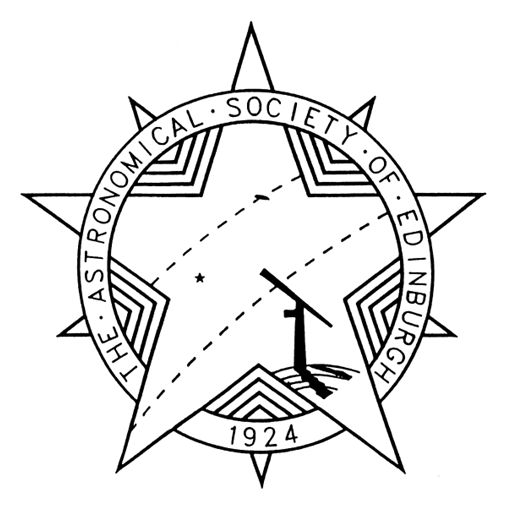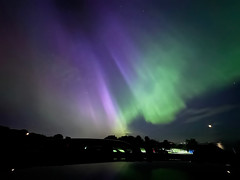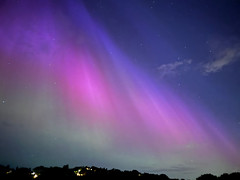Monthly Archives: May 2018
Scotland’s Sky in June, 2018
Three planets outshine the stars during June’s twilit nights

The maps show the sky at 01:00 BST on the 1st, midnight on the 16th and 23:00 on the 30th. An arrow depicts the motion of Mars. (Click on map to enlarge)
Unless our passion is for observing the Sun, Scotland’s brief twilit nights can make June a frustrating month for stargazers. This month, though, three planets outshine all the stars, while a fourth, the handsome ringed world Saturn, is at its best for the year.
We are approaching the summer solstice, due this year at 11:07 BST on the 21st when the Sun is overhead at the Tropic of Cancer. On that day, it passes 57.5° high in the south for Edinburgh at 13:14 BST, the time of local noon.
The middle of the following night sees the Sun 10.6° below the northern horizon for Edinburgh and a mere 6.4° below for Lerwick in Shetland which is why, over northern Scotland in particular, only the brighter stars and planets may be glimpsed.
Edinburgh’s sunrise and sunset times change from 04:35/21:47 BST on the 1st, to 04:26/22:03 on the 21st and 04:31/22:02 on the 30th. The Moon is at last quarter on the 6th, new on the 13th, at first quarter on the 20th and full on the 28th.
Our chart is timed for around the middle of the night at present and depicts three of those planets as they line up low across our southern sky. Even brighter, though, is the brilliant Venus which blazes at magnitude -4.0 low in the west-north-west after sunset and sinks to set in the north-west at 00:36 BST on the 1st and just before midnight by the 31st.
Although it is still drawing away from the Sun, Venus sinks lower each evening as it tracks further south in the sky, moving from below Castor and Pollux in Gemini to the western fringe of Leo by the 30th. Look for it 6° to the right of the young Moon on the 16th with the Praesepe star cluster in Cancer just above and to the Moon’s right. On that evening, the planet is 174 million km distant and appears through a telescope as a 75% illuminated disk of diameter 14 arcseconds.
Mercury joins Venus in the evening twilight later in the month but is a real challenge to spot through binoculars from our latitudes. For us, the little innermost planet shines at about magnitude 0.0 but stands only 2° high in the north-west one hour after sunset from the 20th onwards.
Foremost among the planets on our star chart is Jupiter which is prominent at magnitude -2.5 in Libra as it moves from low in the south-south-east at nightfall to the south-south-west by the map times. Having stood directly opposite the sun at opposition on 9 May, it dims slightly to magnitude -2.3 and shrinks to 41 arcseconds across by June’s end. Binoculars reveal its four main moons to either side and the interesting double star Zubenelgenubi less than a degree to its south over the coming nights. Catch it just below the Moon on the 23rd.
This month it is Saturn’s turn to reach opposition when it stands 1,354 million km away on the 27th when it also happens to lie close to the Moon. It passes less than 12 degrees high in the south as seen from Edinburgh in the middle of the night as Vega, the leading star in the Summer Triangle, passes just to the south of overhead.
Improving from magnitude 0.2 to 0.0 to equal Vega in brightness, Saturn is creeping slowly westwards just above the Teapot of Sagittarius though this asterism barely clears our southern horizon. Viewed telescopically, Saturn’s disk is 18 arcseconds broad at opposition while its rings span 41 arcseconds and have their north face tipped 26° towards us.
The night’s final planet, Mars, is rising above Edinburgh’s south-eastern horizon at our map times and climbs to lie 10° high in the south-south-east before dawn. Its orange hue is already conspicuous at magnitude -1.2 and it more than doubles in brightness to magnitude -2.1 by the 30th. Moving eastwards against the stars of Capricornus, it reaches a so-called stationary point on the 28th when its motion reverses to westerly.
Mars approaches from 92 million to only 67 million km during June while its orange-red disk swells from 15 to 21 arcseconds in diameter, becoming large enough for most decent telescopes to reveal something of its surface detail and that its icy south polar cap is tipped at 15° to our view. Mars lies near the Moon on the morning of the 3rd and to the left of the Moon on the 30th.
I mentioned solar observing at the beginning of this note since our long summer days give ample opportunities for viewing the Sun’s surface, or so we hope. Of course, I should repeat the serious warning that we must never look directly at the Sun through any binoculars or telescopes – to do so invites critical damage to the eyes, if not blindness. Instead it is possible to project the Sun’s image onto a card held away from the eyepiece. Alternatively, obtain an inexpensive but certified “solar filter” and follow the instructions carefully on how to employ this.
Of particular interest are sunspots, dark regions on the solar surface that last for anything from a day to several weeks and mark magnetic storms. Their numbers fluctuate in a cycle of roughly 11 years and, following a peak in activity in 2014, are low at present as we near a so-called sunspot minimum which might be due in 2020. However, sunspot numbers have plummeted in recent months and more than half the days in 2018 have been spotless so far, so it is suggested that the official minimum could occur rather earlier than expected.
Diary for 2018 June
Times are BST
1st 02h Moon 1.6° N of Saturn
3rd 13h Moon 3° N of Mars
6th 03h Mercury in superior conjunction on Sun’s far side
6th 20h Last quarter
13th 21h New moon
14th 14h Moon 5° S of Mercury
16th 14h Moon 2.3° S of Venus
16th 21h Moon 1.2° S of Praesepe in Cancer
20th 06h Venus 0.8° N of Praesepe
20th 12h First quarter
21st 11:07 Summer solstice
23rd 20h Moon 4° N of Jupiter
27th 14h Saturn at opposition at distance of 1,354 million km
28th 05h Moon 1.8° N of Saturn
28th 06h Full moon
28th 15h Mars stationary (motion reverses from E to W)
Alan Pickup
This is a slightly revised version, with added diary, of Alan’s article published in The Scotsman on May 31st 2018, with thanks to the newspaper for permission to republish here.
City light pollution could get worse
For the amateur astronomer in a city, the biggest obstacle is light pollution, mainly from street lighting. Until recently, most street lights were sodium discharge lamps, initially low pressure (LPS), but later high pressure (HPS). These lamps gave good and efficient lighting although the LPS lamps gave poor colour rendering (better with HPS).
For amateur astronomers, because sodium lamps produce virtually monochromatic light in a small wavelength band averaging about 593 nm, the light pollution (skyglow) could be removed by using optical glass filters although nowadays the filtering can be achieved via astronomy software for astrophotograhy.
For this discussion colour temperature is important; that is the temperature at which a black body would emit radiation of the same colour as a given object. The relationship between colour and temperature is familiar to astronomers because it is how stars are classified. The colour temperature of LPS is 1800 K while the SON type of HPS has a colour temperature of 2700 K (the higher the colour temperature, the bluer the light). HPS lamps give a wider colour spectrum, but can still be filtered.
Like many cities across the world, the City of Edinburgh Council (CEC) has begun to replace sodium street light luminaires with light-emitting diode (LED) clusters. The case for this change is that LEDs are more energy efficient (using less electricity) and give a nearly full spectrum of light. The colour temperature of CEC’s LEDs is between 3700 and 4300 K. (For comparison moonlight has a colour temperature of 4100-4150 K and for daylight it is about 6000 K.) As a result, LED street lights emit much more blue-rich light than HPS lamps. This can impede night sky observations and also affect the health of humans, plants and animals. There is even evidence that exposure to this blue light can increase the risk of breast and prostate cancer.
Unfortunately for amateur astronomers, blue light is far more polluting than red or yellow light as the amount of light scattered by small particles in the atmosphere is inversely proportional to the wavelength. Blue light also contributes to glare, a growing problem in brightly-lit cities [1].
This is a matter that greatly concerns the International Dark-Sky Association (IDA) [2]. Its Fixture Seal of Approval (FSA) provides objective, third-party certification for luminaires that minimize glare, reduce light trespass and do not pollute the night sky. In 2014 the FSA programme began requiring lighting that has a colour temperature of 3000 and lower (up to 3220 K actual measured value). However, with the rapid pace of technological advance in the lighting industry, the IDA is likely to reduce its recommendation to 2700 K or lower. The IDA seeks the best possible scenario for new LED installations and retrofits to replace old technology without increasing light output and minimizing short wavelength emissions while also decreasing operational costs and energy consumption.
In April this year I asked CEC if they would be following the IDA’s recommendations, but their response was to claim that their design and specifications are in line with current British Standards (these appear to require LEDs to have a minimum colour temperature of 4000 K). Understandably, CEC would be reluctant to change its specification for LEDs.
ASE is the only amateur organisation in Edinburgh that can legitimately express a view on this matter. Consequently ASE should press CEC to correct its present specification to reduce light pollution to reduce skyglow, if for no other reason of which there are many. Without this change, Edinburgh residents are unlikely to see much of the night sky and amateur astronomers will be frustrated.
References:
- ‘Night skies get the blues’ by Gabriel Popkin in Physics World, March 2015.
- http://darksky.org/
Steuart Campbell



